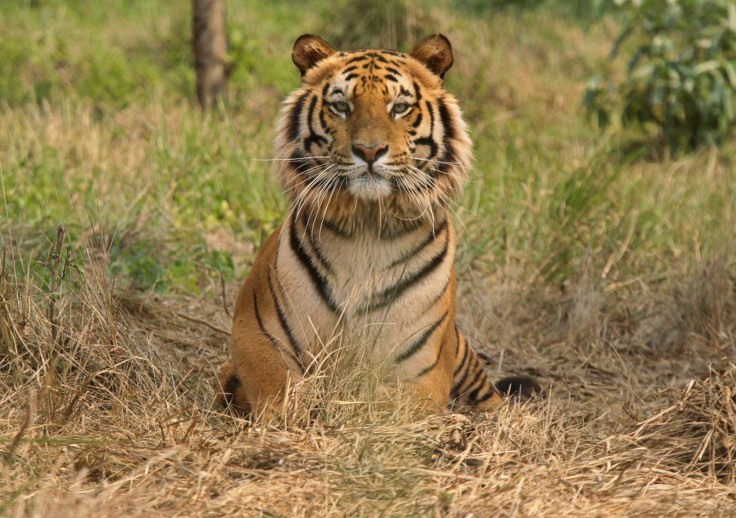India: Tiger census method flawed says Oxford study casting doubt on 30% rise in numbers

Just weeks after the Indian tiger census announced a whopping 30% rise in tiger numbers, an Oxford study has questioned the double-sampling methodology used in the survey.
While not directly disputing a rise in tiger numbers, the study points to a measuring error in the census which may not give an accurate picture of population changes.
Published in Methods in Ecology and Evolution, the study by scientists from the University of Oxford, Indian Statistical Institute and Wildlife Conservation Society used a mathematical model to test the index calibration technique along with field data to conclude it had poor predictive power.
The team suggests using alternative methods of counting rare animals that avoid the pitfalls of the index-calibration approach.
Arjun Gopalaswamy, lead author of the report from the Wildlife Conservation Research Unit at Oxford University's Department of Zoology, said: "Our study shows that index-calibration models are so fragile that even a 10 percent uncertainty in detection rates severely compromises what we can reliably infer from them. Our empirical test with data from Indian tiger survey efforts proved that such calibrations yield irreproducible and inaccurate results."
Extensive use of man-made roads by tigers where tiger tracks often get deleted is a pointer to such uncertainty in detection.
Claim rebutted
However, experts from India's Wildlife Institute of India, involved in the tiger census have in turn claimed the Oxford study was poorly designed and the datasets used in the model are unreliable.
The index-calibration technique relies on measuring animal numbers accurately in a relatively small region using reliable, intensive and expensive methods (camera traps) and then relating this to a more easily obtained, inexpensive indicator (such as animal track counts) by means of calibration.
The calibrated-index is then used to extrapolate actual animal numbers over larger regions.
Both when using the model with different values, and in deriving tiger numbers from field data fed into the model, the index-calibration method failed. Any degree of success was shown to be chance.
"It is not surprising that they haven't found a strong relationship of tiger density with tiger signs or any other variable for that matter. No amount of statistical sophistication can compensate for poor study design," Yadvendra D Jhala and Qamar Qureshi from Wildlife Institute of India, told Times of India.
The study has used old data, they said. "The paper uses 10 year old data from Maharashtra by Karanth and colleagues where densities as high as 12 to 16 tigers per 100 sq km have been reported from four sites. It is indeed surprising to see this, as there have never been tiger densities in Maharashtra that are this high."
They plan to come up with a scientific paper as a rejoinder.
To a question on how the study actually affects the tiger census, Arjun Gopalaswamy preferred to play safe, when he clarified to IBTimes UK, "Our paper focuses on statistical methodology issues of index-calibration experiments and is applicable to all sorts of problems, both wildlife and non-wildlife related. This is not about tiger numbers as such. Since, details of the exact method/model used to come up with the tiger census estimates and its associated variances are not available to us we cannot make statements. It will require another study anyway."
The study highlights the challenge of counting rare and elusive animals and the model provides the crucial 'link' between some of the older methods (which don't estimate detection rates) with some of the newer methods (which do estimate detection rates).
Professor David Macdonald, a co-author and the founding Director of the Wildlife Conservation Research Unit at Oxford University's Department of Zoology, said: "Index-calibration can work well, if the correlations are tight and consistent, but often they aren't, and many of us, myself included, for example in the context of estimating numbers of mink and water voles in the UK, have been using the technique without appreciating its risks."
K Ullas Karanth, the director of the Centre for Wildlife Studies in India, had said shortly after the census figures was announced that it did not use the best available methodology and could not accurately measure changes.
Karanth has for long been advocating an annual camera-trap survey of important habitats instead of the 'double sampling' approach every four years that correlates camera data with unreliable ground surveys.
Fixing animal terrain
A recent joint research paper by researchers of the Wildlife Conservation Society – India Program, University of Florida, Wildlife Trust of India and Yale University, had identified potential animal dispersal routes, away from corridors demarcated by humans.
Their occurrence was shown to coincide with areas of minimal threat or resource constraint.
"Animals do not exclusively seek and use corridors demarcated by humans to move across landscapes. In reality, we know that tigers, elephants and other animals use fields, plantations and other human-modified lands for movement in addition to corridors," said Dr Divya Vasudev, lead author of the paper which sought to identify potential movement routes for animals in a landscape.
Sizeable numbers of tiger populations thrive in the areas adjoining protected areas.
Half the reported deaths of 274 tigers in the last four years have been from areas outside tiger reserves.
Detection rates used in the census method is based on what is demarked as animal terrain.
India's tiger census released in January has shown a 30% rise in the tiger population over the last three years.
The survey accounted at least 2,226 tigers in forests across the country up from the 1,706 counted in 2011.
Loss of habitat of tigers is the bigger worry for many conservationists who are not unduly concerned over census figures. Originally occupying 380,000 sq km of existing forests, tigers are now found in just half that area.
© Copyright IBTimes 2025. All rights reserved.





















